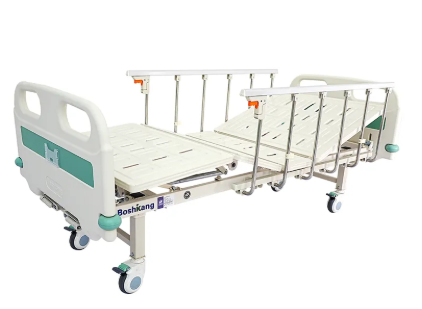Hướng dẫn thiết yếu để đầu tư thông minh Giường bệnh Đầu tư
Chọn đúng giường bệnh đại diện cho một khoản đầu tư quan trọng vào chăm sóc và sự thoải mái cho bệnh nhân. Dù bạn là quản lý cơ sở y tế hay một cá nhân đang tìm mua giường bệnh viện dùng giường bệnh cho trang chủ tại nhà, việc ra quyết định sáng suốt có thể ảnh hưởng lớn đến chất lượng chăm sóc và quản lý ngân sách. Thị trường hiện cung cấp nhiều lựa chọn giường bệnh, từ các mẫu cơ bản dùng thủ công đến các hệ thống điện tử phức tạp với tính năng tiên tiến. Hiểu rõ cách lựa chọn giữa các tùy chọn này đồng thời tối ưu hóa giá trị mua sắm là rất quan trọng để đưa ra quyết định mua đúng đắn nhất.

Hiểu rõ phân loại giường bệnh viện
Giường bệnh viện dùng thủ công và giường bệnh viện điện
Giường bệnh viện loại cơ được vận hành thông qua tay quay hoặc hệ thống thủy lực, cung cấp các chức năng định vị cơ bản với mức giá thấp hơn. Mặc dù cần dùng sức để điều chỉnh, chúng vẫn rất đáng tin cậy và yêu cầu ít bảo trì. Ngược lại, giường bệnh viện điện được trang bị chức năng điều khiển bằng mô-tơ thông qua điều khiển từ xa hoặc bảng điều khiển, cho phép dễ dàng điều chỉnh độ cao, vị trí đầu và chân. Mặc dù nói chung đắt hơn, các mẫu giường điện giúp giảm bớt căng thẳng cho người chăm sóc và tăng tính độc lập cho bệnh nhân.
Các tùy chọn chuyên dụng và dành cho bệnh béo phì
Giường bệnh viện chuyên dụng đáp ứng các nhu cầu y tế cụ thể hoặc tình trạng bệnh lý đặc biệt, tích hợp các tính năng như bề mặt giảm áp lực hoặc cân tích hợp. Giường bệnh viện dành cho bệnh béo phì (bariatric) được thiết kế dành cho bệnh nhân có kích thước lớn hơn, với khung gia cố và bề mặt nằm rộng hơn. Các tùy chọn chuyên dụng này thường có giá cao hơn nhưng lại cung cấp các tính năng thiết yếu cho các nhóm bệnh nhân cụ thể.
Các tính năng chính lý giải cho khoản đầu tư
Sự an toàn và độ bền
Khi đánh giá giường bệnh viện, các tính năng an toàn nên được ưu tiên hàng đầu. Hãy lựa chọn những chiếc giường có hệ thống phanh đáng tin cậy, tay vịn chắc chắn, và nguồn điện dự phòng trong trường hợp khẩn cấp đối với các mẫu giường điện. Các yếu tố về độ bền bao gồm chất liệu khung giường, khả năng chịu tải trọng, và phạm vi bảo hành. Những chiếc giường bệnh viện chất lượng cao thường có khung làm bằng thép với lớp phủ bảo vệ, cơ chế vận hành mượt mà, và chế độ bảo hành toàn diện, điều này có thể khiến chi phí ban đầu cao hơn nhưng hoàn toàn xứng đáng.
Tính Năng Tiện Nghi và Dễ Tiếp Cận
Sự thoải mái của bệnh nhân ảnh hưởng trực tiếp đến quá trình hồi phục và mức độ hài lòng. Các tính năng cao cấp như điều chỉnh độ cao linh hoạt, mặt giường chia thành nhiều khoang có thể điều chỉnh, và bảng điều khiển tích hợp giúp tăng cường sự thoải mái cho bệnh nhân cũng như thuận tiện cho nhân viên chăm sóc. Hãy cân nhắc các loại giường có khả năng kéo dài để phù hợp với bệnh nhân cao lớn và hỗ trợ nhiều loại nệm khác nhau. Mặc dù những tính năng này có thể làm tăng chi phí ban đầu, nhưng chúng thường rất hữu ích trong quá trình sử dụng lâu dài.
Lập Ngân Sách và Phân Tích Chi Phí
Các Yếu Tố Cân Nhắc Ban Đầu
Ngoài giá cơ bản của giường bệnh viện, cần tính đến các chi phí bổ sung như vận chuyển, lắp đặt và đào tạo nhân viên. Một số nhà cung cấp cung cấp các gói khuyến mãi bao gồm phụ kiện như nệm, tay vịn hai bên và thiết bị định vị. Hãy so sánh tổng chi phí mua sắm giữa các nhà cung cấp và mẫu mã khác nhau, lưu ý rằng giá thấp nhất chưa chắc đã là lựa chọn có giá trị tốt nhất. Nên cân nhắc mua hàng vào thời điểm tổ chức hội chợ ngành hoặc cuối năm tài chính khi các nhà cung cấp thường đưa ra mức giá ưu đãi.
Kinh Tế Bảo Trì Dài Hạn
Tính tổng chi phí sở hữu bằng cách cộng thêm chi phí bảo trì, sửa chữa và khả năng thay thế linh kiện. Các loại giường bệnh chất lượng cao từ các nhà sản xuất uy tín thường đòi hỏi sửa chữa ít hơn và có sẵn phụ tùng thay thế tốt hơn. Cần tính đến chi phí cho các chương trình bảo trì định kỳ và việc nhà cung cấp có cung cấp hợp đồng dịch vụ hay không. Mức tiêu thụ năng lượng cho các mẫu dùng điện cũng cần được tính đến trong dự báo chi phí dài hạn.
Chiến lược Đàm phán và Mua sắm
Quy trình Lựa chọn Nhà cung cấp
Nghiên cứu kỹ lưỡng các nhà cung cấp tiềm năng, đánh giá danh tiếng trên thị trường, mạng lưới dịch vụ và tình hình tài chính của họ. Yêu cầu các đề xuất chi tiết từ nhiều nhà cung cấp, so sánh không chỉ giá cả mà còn cả thời gian giao hàng, dịch vụ lắp đặt và hỗ trợ sau mua hàng. Cân nhắc kinh nghiệm của nhà cung cấp với các cơ sở tương tự và khả năng cung cấp thư giới thiệu. Việc xây dựng mối quan hệ với các nhà cung cấp đáng tin cậy có thể dẫn đến mức giá tốt hơn và chất lượng dịch vụ cao hơn theo thời gian.
Lợi ích của Mua sắm Số lượng lớn
Đối với các cơ sở lớn hơn, việc tìm hiểu các tùy chọn mua số lượng lớn có thể mang lại khoản tiết kiệm đáng kể. Nhiều nhà sản xuất cung cấp mức giá theo cấp dựa trên khối lượng đơn hàng. Hãy cân nhắc phối hợp mua hàng với các bộ phận hoặc cơ sở khác để đạt mức chiết khấu cao hơn. Một số nhà cung cấp cũng có thể đưa ra các điều khoản thanh toán linh hoạt hoặc tùy chọn thuê cho các đơn hàng lớn, giúp quản lý dòng tiền trong khi vẫn đảm bảo được thiết bị cần thiết.
Các câu hỏi thường gặp
Giường bệnh nên được thay thế bao lâu một lần?
Tuổi thọ trung bình của một chiếc giường bệnh viện dao động từ 10-15 năm nếu được bảo trì đúng cách. Tuy nhiên, thời điểm thay thế còn phụ thuộc vào mức độ sử dụng, chất lượng bảo trì và nhu cầu nâng cấp công nghệ. Việc đánh giá định kỳ sẽ giúp xác định thời điểm thay thế phù hợp nhất.
Chế độ bảo hành tôi có thể nhận được là gì?
Chế độ bảo hành tiêu chuẩn thường bao gồm khung giường và các bộ phận cơ học trong khoảng 1-5 năm, các linh kiện điện tử thường được bảo hành từ 1-2 năm. Các nhà sản xuất cao cấp có thể cung cấp tùy chọn bảo hành kéo dài. Hãy luôn đọc kỹ các điều khoản bảo hành và cân nhắc thêm các gói bảo hiểm cho các bộ phận quan trọng.
Giường bệnh viện đã qua sử dụng có phải là lựa chọn tiết kiệm chi phí không?
Giường bệnh viện đã qua sử dụng và được chứng nhận có thể mang lại mức tiết kiệm đáng kể nhưng vẫn đảm bảo tiêu chuẩn chất lượng. Tuy nhiên, hãy đảm bảo chúng đến từ các nhà cung cấp được ủy quyền, có chế độ bảo hành đi kèm và đáp ứng các tiêu chuẩn an toàn hiện hành. Yêu cầu cung cấp tài liệu chi tiết về quy trình tân trang và chứng nhận tuân thủ quy định y tế.


